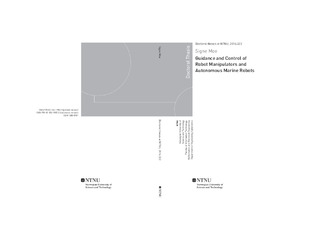| dc.description.abstract | This thesis is motivated by the increasing use of robots within numerous fields and in a vast range of applications. The use of robots provides several advantages, e.g. reduced labor costs, increased production and productivity, high precision and flexibility. Fully autonomous robotic systems operate independently of humans, and there is a strong desire to utilize robotic systems to completely automate processes, also outside of the production industry.
The singularity-robust multiple task-priority inverse kinematics framework is a widely used kinematic control method for a general robotic system. This framework allows several equality tasks, i.e. tasks with a defined desired value (for instance end effector position), to be defined, prioritized and achieved simultaneously. However, for a general robotic system, several goals may be described as set-based tasks, which are tasks that have a desired interval of values rather than one exact desired value, e.g. collision or joint limit avoidance. In this thesis, a systematic approach to include set-based tasks into this framework is presented. It is proven that set-based tasks given high priority, i.e. above the highest priority equality task, are satisfied at all times, but that the same cannot be guaranteed for low-priority set-based tasks. The resulting closed-loop dynamic system can be described as a discontinuous differential equation, and by using switched control systems theory it is proven that the equality task errors converge asymptotically to zero when including setbased tasks into the framework given that certain, specified conditions are satisfied. Simulation and experimental results are presented which confirm the correctness and effectiveness of the proposed method. An unmanned marine vehicle may be considered a type of robotic system. However, these vehicles pose some additional challenges due to hydrodynamic effects, underactuation, thrust allocation, communication and environmental influence. A cornerstone ability of autonomous marine vehicles, both surface and underwater, is to converge to and follow a general path under the influence of ocean currents. This thesis presents two approaches to achieve this for surface vehicles, one of which is based on absolute velocity measurements only, and one which assumes that relative velocity measurements are available. The latter has also been extended to the underwater case. Common for these results are the fact that the control system is designed to make the vehicle side-slip such that the total vehicle velocity is aligned with the desired path, even if the heading is not. This is necessary to counteract both for the curvature of the path and the ocean current. Convergence to the desired path is achieved with asymptotic stability properties under explicit conditions. For surface vehicles the results hold globally, whereas for underwater vehicles they hold for a defined domain (due to the well-known singularity of Euler angle representation).
Another highly important ability of autonomous marine vehicles is to avoid collisions, and in nautical navigation all surface vessels are subject to the International Regulations for Preventing Collisions at Sea (COLREGs). This thesis introduces a switched guidance system for underactuated surface vehicles to achieve collision avoidance and path following. The proposed method is based on set-based control, is adapted to the underactuation of marine vehicles, is highly generic, and may be used for any combination of methods for path following and collision avoidance. A specific guidance law for the collision avoidance mode is suggested that will, if satisfied, make the surface vessel track a circle with a constant safe radius about the moving obstacle center in a COLREGs compliant manner. The set-based guidance system is proven to prevent collisions given that certain, specified assumptions on the obstacle velocity are satisfied and the references provided by the guidance system are tracked. Furthermore, path following is achieved as long as the surface vessel can safely follow the path without colliding. | nb_NO |
